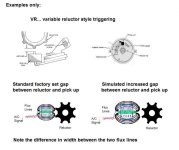Mike and all, in retrospect, perhaps should have said; "And by the way.... an incorrect gap may cause a change to dwell!"
Would that sound better to you guys?

I read the PDF file. Perhaps the author saw no need to elaborate any further since these systems are pre-set and require a prescribed gap.
But let me explain what I've learned about this... and I may not be 100% correct.
We all know that an ignition coil's primary winding must undergo saturation time (either via dwell angle, or dwell by ms of saturation time) and that the ignition coil's primary winding must be allowed to collapse in order for the secondary winding to produce a high energy spark.
To the best of my knowledge, Chrysler Marine OEM has used the Chrysler auto VR system (I.E., variable reluctor) modified for Marine use. Similar to other magnetic triggering devices, each reluctor wheel "point" sets up a field of energy as it passes by the pick up coil. This can be refered to as a flux field.
If we deviated from OEM spec (gap between the reluctor wheel point and the pick up coil), don't we essentially also make a change to the flux feild's width?
If that answer is yes......, then doesn't that also affect the dwell or dwell angle to some degree? (no pun intended)
Here's my rather amaturish drawing.
Note that I'm showing one flux field being larger as a result of the larger gap.


